Abstract
In general, the sensor lamps in the corridors, stairwells, or toilets of buildings will change from completely dark to full brightness when someone passes by. It will make the human eyes feel very uncomfortable, and when the sensor lamp is completely dark, the whole corridor and stairwell will be dark, making women and children feel insecure at night. If the lighting is changed to be sensor-less, there is a serious problem of wasted energy. To solve this dilemma, we developed a new type of “LED sensor lamp with low-light mode” that changes the original “full dark mode” to “low-light mode”. As such, when someone approaches the sensor lamp, their eyes will not be uncomfortable with the momentary illumination. Furthermore, when no one passes by, the sensor lamp will stay in low-light mode, so that people returning home at night no longer have to go through dark corridors, thereby achieving safety, aesthetics, and energy-saving purposes. This new sensor lamp’s power consumption in low-light mode is only 1/10 of the high-light mode, but its brightness can be up to half of the high-light mode, making it very suitable for parking lots, corridors, stairways, or toilets of buildings. It only requires the replacement of the lamp but not the original lamp socket, yet the basic brightness can be maintained. Take the general 15W T8 LED lamp (sensor-less) as an example: if it is replaced by this new type of sensor lamp, and the place where it is installed is rarely passed by people, the power saving rate will be as high as 90%. Assuming that there are 12 passers-by per hour, the saving rate is still 81%.
1. Introduction
Global warming keeps worsening and climate anomalies are occurring increasingly frequently around the world. After the Kyoto Protocol, which aims to curb the global greenhouse gas emissions, came into force on 16 February 2005, the innovation of energy technologies and the change of social behavior for energy conservation will be an effective strategy for carbon dioxide reduction [1]. Due to the growing influence of global warming and the rapid changes in the ecological environment, many unusual ecological crises have started to occur all over the world. Therefore, the search for “renewable energy” is a matter of great importance to all governmental and non-governmental organizations. For the U.S., the UK, and China, the goal is for renewable energy to account for at least 20% of total electricity generation by 2020, and it is expected that renewable energy will contribute more than 50% of total electricity generation in some countries by 2050 [2,3,4].
Energy-saving, smart building, and green building have recently become compelling topics, and lighting control design is tailored to the needs of each location in buildings to reduce power consumption [5,6]. Artificial lighting accounts for a significant portion of the world’s electrical energy consumption. In office buildings in particular, artificial lighting may account for up to 40% of the total energy consumed [7]. In fact, the use of LED technology in lighting systems can save energy [8]. The development and application of LED technology are changing rapidly, the use thereof can reduce the required power value of lighting, enhance their durability, as well as achieving environmental protection and low power consumption [9,10,11,12]. LED lighting will eventually replace traditional lighting due to environmental protection, energy-saving and economic cost considerations. In addition to its long life, environmental protection, and safety advantages, LED lighting is more energy efficient than traditional lighting, consuming only half the power of a fluorescent lamp and one eighth the power of a light bulb [13].
According to the latest report “2018 Commercial Lighting, Smart Lighting and Panel Light Market Report” from LEDinside, a green-energy division of the market research firm TrendForce, the global LED commercial lighting market has continued to expand in recent years due to the energy efficiency and cost effectiveness of LED luminaires, which are gradually recognized by consumers. The global LED indoor commercial lighting market would reach USD 15.87 Billion in 2018, accounting for 42% of the global LED lighting production value [14].
Although the luminous efficacy of LED lighting is excellent, twice as good as fluorescent lamp, take the underground parking lot of the building for example: it must be lit 24 h a day and its area is very large, so even if all the lights are replaced with LED lighting, the electricity bill is still very high. Furthermore, due to safety or aesthetic reasons, many buildings must maintain a basic level of brightness in the corridors and stairwells at night, resulting in untold amounts of wasted electricity.
To implement “energy-saving and carbon reduction”, many schools and government agencies have replaced all the lights in the corridors, stairwells, or toilets with sensor lamps. However, most lights must be controlled by an external circuit for the sensors to function. When sensing someone passing by, it will change from full darkness to full brightness, so the human eyes would feel very uncomfortable. Moreover, when the sensor lamp is full dark, the whole corridor and stairway will be dark, which will make people feel insecure when returning home at night. However, if we change the lighting to be sensor-less, we will have to face the problem of wasting energy again.
To solve this dilemma, we developed a new type of “LED sensor lamp with low-light mode” that changes the original “full dark mode” to “low-light mode”. As such, when someone approaches the sensor lamp, their eyes will not be uncomfortable with the momentary illumination. When no one passes by, the sensor lamp stays in low-light mode, so that people returning home at night no longer must go through dark corridors, thereby achieving safety, aesthetics, and energy-saving purposes.
In addition to indoor lighting applications, this technology is also suitable for outdoor lighting or solar-powered LED lighting systems. Stand-alone solar power systems are used in remote areas not accessible by grid power [15]. The system must be designed with a good matching between the installed capacity of solar photovoltaic module and battery capacity to obtain a proper loss of load probability (LLP) [16]. Therefore, the power consumption of the solar-powered LED lighting system must be as low as possible. This product’s power consumption is only one-tenth of that of general lighting, so it is very suitable for stand-alone solar power LED lighting systems.
The concept of energy-saving in that article [17] is the same with ours; however, the structure of their LED light is suitable for large-scale area, and ours is for private and smaller one. They must set up a server and complicated wirings to detecting illumination and user movement to control the intensity of LED light. It costs a lot money and waste of time to save 58% energy consumptions. Nevertheless, our design could save more energy consumptions without setting up any server and wirings but only change T8 LED tube to our new type of sensor lamp.
Conventional LED sensor lamps have a common problem: they only have two modes—full dark mode and full light mode, which makes the human eyes very uncomfortable. Imagine what it would be like if the whole corridor is sensor-lit. The corridors of the five-star hotels in Europe are all equipped with sensor lamps to save energy. When customers enter the corridor, they will see darkness in front of them, and they must go forward and then the lamps in the corridor will be lit up one by one. Although this has the effect of saving electricity, human eyes may feel uncomfortable when the lamps are first turned on.
The following are the problems of ordinary sensor lamps:
- They have only two modes: full dark mode and full light mode, which is very uncomfortable for the human eyes.
- In the full dark mode, the entire corridor is dark, making women and children feel insecure when returning home at night.
- The trigger would not be activated again when the sensor lamp is on.
2. New Type of LED Sensor Energy-Saving Lamp with Low-Light Mode
General sensor lamps are fully illuminated when people pass by and completely dimmed when there is no one passing by. Although it can achieve the purpose of energy-saving, it also produces the problems mentioned earlier. This work aims to improve this technical problem to develop a new generation of more energy-efficient “New type of LED sensor energy-saving lamp with low-light mode”.
2.1. Introduction of Works
We have developed a new type of “LED sensor energy-saving lamp with low-light mode”, which changes the original “full dark mode” to “low-light mode”. As such, when someone approaches the sensor lamp, his/her eyes will not have adjustment issue. When no one passes by the corridor and stairwell, the sensor lamp will be half-lit, so when someone passes by, he/she does not have to face a dark corridor in front of them, thereby achieving the purpose of safety, aesthetics and energy-saving.
The new LED sensor energy-saving lamp we developed enters low-light mode when no one is around, the brightness is about half of the high light, and the power consumption is only about one-tenth thereof and adjustable. Meanwhile, when someone is passing by, it will enter the full brightness high-light mode. In addition, we also changed our sensor lamp from single triggering to continuous triggering, which will continue to be triggered as long as the user is still around. Therefore, this new type of LED sensor energy-saving lamp is very suitable for parking lots, corridors, stairwells, or toilets in buildings. It can maintain basic brightness, and the power saving rate is up to 90% (assuming that there are seldom people passing by the installation site, and ignoring the power consumption of the circuit, with only the power consumption of the lamp tubes is calculated. It will be described in detail in the next section). It completely eliminates the shortcomings of conventional LED sensor lamps.
The LED particles have a higher energy conversion efficiency (the efficiency of converting electrical energy to light energy) at a lower light level, making LED ideal for use in low-light requirements [18]. As a result, we only need to supply 10% of power for the LED particles to reach nearly half the brightness. Furthermore, in most cases, the light decay of LED is caused by high temperature, but this new LED sensor energy-saving lamp mostly operates in low-light mode, and the current is only 10%, so the temperature is very low. Therefore, it can reduce the light decay of LED and its life will be about twice to three times that of the general LED. Presently, there are three types of products we created: recessed light, T5 mountain ceiling lamp and T8 lamp tube. The first two are with external circuits on the bulb or lamp tube (Figure 1 shows a T5 mountain ceiling lamp).
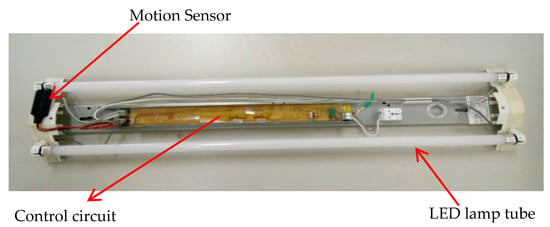
Figure 1.
LED sensor energy-saving lamp (T5 mountain ceiling lamp).
Another latest product of ours puts the control circuit and motion sensor into a T8 LED tube with no external circuit required (Figure 2). As such, users can remove the original T8 lamp tubes (fluorescent or LED lamps) and replace them with our new T8 LED sensor energy-saving lamp:

Figure 2.
LED sensor energy-saving lamp (T5 mountain ceiling lamp).
2.2. System Block Diagram
Below is the system block diagram of the “New type of LED sensor lamp with low-light mode” to illustrate how the circuit design achieves the energy-saving effect:
The bridge rectifier converts the main supply voltage of 110 V/220 V AC power into pulsating DC power, and then the voltage detection chip determines if it is 110 V or 220 V. If the voltage is 110 V, SW1 and SW2 will be ON, SW3 will be OFF, and LED1 and LED2 are connected in parallel. If the voltage is 220 V, SW1 and SW2 will be OFF, SW3 will be ON, and the LED1 and LED2 are connected in series, so that this sensor lamp can receive the full voltage of 110 V/220 V.
The constant current circuit makes judgments according to the detection results of the microwave sensor. If someone is passing by (in high-light mode), a high signal will be sent to CC1 and CC2, then CC1 and CC2 will provide a current of 100%. If no one is detected (low-light mode), a low signal will be sent to CC1 and CC2, and CC1 and CC2 will only supply a current of 10% (this circuit is designed to be flexible in setting the current with the jumper, and the setting range is 10% to 20%).
In addition, the output of the bridge rectifier in Figure 3 is pulsating DC instead of stabilized DC voltage because the bridge rectifier has a better power factor (PF) when pulsating DC is adopted. In the CE (Conformite Europeenne) safety regulations, it is stipulated that if a LED light consumes more than 25 W of power, the PF value must be greater than 0.9. If the power consumption is between 5 W and 25 W, the PF value must be greater than 0.7. If the power consumption is less than 5 W, the PF value only needs to be greater than 0.5.
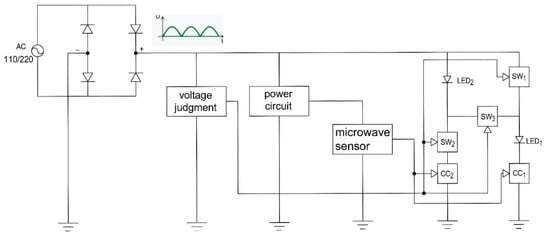
Figure 3.
System block diagram of LED Sensor lamp.
3. Energy-Saving Analysis
3.1. Calculation of Power Consumption
Since this new type of sensor lamp has high-light mode and low-light mode, the calculation of power consumption is more complicated unlike the simple calculation of general sensor-less LED lamp. This new type of sensor lamp enters low-light mode when no one is passing by, and its power consumption is only one-tenth of that of high-light mode. When someone is passing by, the sensor lamp will be fully lit for 30 s, so the factors affecting the power consumption are: the duration of the activation, the frequency of people passing by, whether a continuous trigger is activated, and so on. However, to derive the equation, we assume that people do not stay long when passing by and it takes 30 s for the next person to pass by, i.e., there will be no continuous trigger. Furthermore, the durations that people pass by are equal (if they are not equal, the total power is still the same, but the formula is more difficult to derive) and dispersed.
Let us use the below figure (Figure 4) “Power variation diagram for high-light mode and low-light mode” to illustrate how to calculate the hourly power consumption of this new type of sensor lamp.
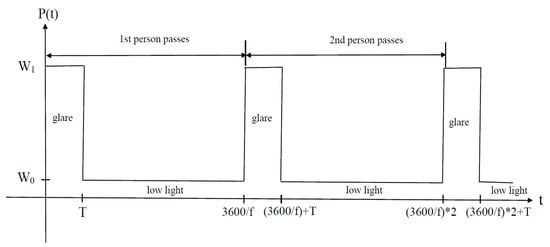
Figure 4.
Power variation diagram for high-light mode and low-light mode.
P(t) illustrates the power change between the high-light mode and the low-light mode, and the meanings of other parameters are as follows:
- T:
- The number of seconds in which the high-light mode is maintained when someone passes by. The current setting is 30 s.
- f:
- Number of passer-by per hour, i.e., the number of times that high-light mode is trigger per hour.
- W1:
- Power for high-light mode. The current power for the high-light mode of this product is 15 W (the power of the lamp tube).
- W0:
- Power for low-light mode. The current power for the low-light mode of this product is 1.5 W (the power of the lamp tube).
Since it was previously assumed that “the durations that people pass by are equal and dispersed”, the duration in which a person passes by is 3600/f (for f > 0). For the first person, duration between 0 and T seconds is in the high-light mode, the duration between T and 3600/f seconds is the low-light mode, so we can calculate the consumed power per lamp per hour (Eph) as follows:
In addition, we assume that each lamp will be on for 8 h a day, meaning that the lamp will be on for a total of 2920 h (8 × 365) per year, so the annual power consumption (Epy) of this new sensor lamp is:
For an ordinary sensor-less 15W T8 LED lamp (operates only in 15W full light mode), the power consumption per lamp per year is (15W/1000) × 2920 = 43.8 kw h. If the “ordinary” sensor-less 15W T8 LED lamp is replaced with our “new type of sensor lamp”, we can calculate the Energy-Saving Rate (ESR), kilowatt-hour saved per lamp per year (Dpy), cost saved per year (Mpy) assuming it costs NT$4 per kilowatt-hour), and the carbon emission reduced per year (Cpy) as follows (1 KW⋅h can generate 0.623 kg CO2e of carbon emission):
ESR = (15 − Eph)/15 × 100%
Dpy = 43.8 − Eph × 2920 kw h
Mpy = (43.8 − Eph × 2920) kw h × 4 dollar/kw h
Cpy = (43.8 − Eph × 2920) kw h × 0.623 kg CO2e/kw h
3.2. Calculation of Energy-Saving Rate
Since the ESR of this new type of sensor lamp is closely related to the number of times of high-light mode is triggered per hour (f), this section investigates the relationship between “ESR” and “number of times of high-light mode is triggered per hour (f)” and calculates the maximum and minimum values of the ESR.
First of all, we know from Equation (4) that “energy-savings rate” is inversely proportional to “the amount of electrical energy consumed per lamp per hour (Eph)”, and we also know from Equations (1) and (2) that Eph is directly proportional to the number of times of high-light mode is triggered per hour (f). As such, the ESR is inversely proportional to the number of times of high-light mode is triggered per hour (f), meaning that the more times the high light is triggered, the lower the ESR.
Now, let us look at the range of the number of times of high-light mode is triggered per hour (f). The minimum value is 0, which means no one passes by in an hour, and the maximum value is 3600/T, which means that T seconds after someone passes by each time, another person passes by immediately without interruption (that is, the high-light mode is on the whole hour). Therefore, the range of f is . The T-value of this product is 30 s, so the range of f here is . We bring different f-values into the Eph formula to calculate the Epy, ESR, Dpy, Mpy, and Cpy values of each lamp with different f-values (compared with the general sensor-less 15W T8 LED lamp), and the below table (Table 1) only lists the important portions (f-values with an interval of 6):

Table 1.
Epy, ESR, Dpy, Mpy, and Cpy values for each lamp with different f-values.
From the above table, it can be seen that 90% of the maximum value of the ESR occurs when f = 0 (meaning no one has passed by for 1 h), and the same is true for other values of Epy, Dpy, Mpy, and Cpy. The ESR decreases linearly with the increase of f. When f = 120 (meaning that people pass by continuously for 1 h), the ESR decreases to 0%. However, this is unlikely to happen, as sensor lamps are usually installed in areas where people are less likely to pass by. The diagram below (Figure 5) shows the relationship between the ESR and the f value.
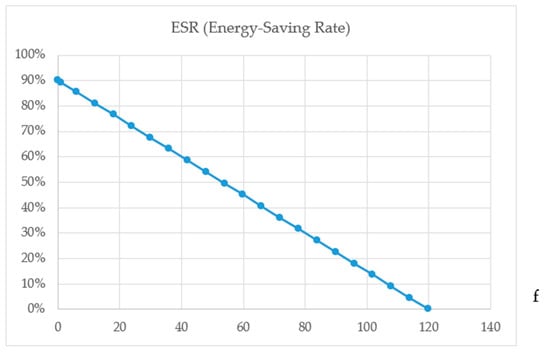
Figure 5.
Relationship between energy-saving rate (ESR) and f.
3.3. Energy-Saving Examples
We would like to use the example of Cheng Shiu University for energy-saving analysis. Most of the lights in the corridors, parking lots, stairwells, and toilets in its campus buildings are 15W T8 LED lamps (sensor-less), and it is estimated that there are about 3000 of them. Assuming that all of them are replaced with this new type of LED sensor energy-saving lamps, we will show the energy-saving effect and the expected effect by the “reduction of power consumption in the same period of one year”.
Since the brightness of the 15W T8 LED sensor lamp (in high-light mode) is the same as that of the general 15W T8 LED sensor-less lamp, the school can replace the original 15W T8 LED lamp (sensor-less lamp) with this product. Although they can simply replace the lamp tubes without replacing the lamp sockets, the basic brightness can also be maintained, so the energy-saving efficiency is expected to be good.
We will use 3000 lamps as the basis for estimating the “reduction of power consumption in the same period of one year”, but in order to calculate the power consumption in a more accurate way, we assume that there will be 12 people passing by each lamp per hour (about 1 person passing by every 5 min, which is a more average number because the use rate of lamps in 1st floor is very high but that for the other floors will be very low).
We can calculate it by directly referencing to Table 1 (taking the Epy, Dpy, Mpy, and Cpy values when f = 12):
- The power consumption of 3000 lamps per year (when f = 12, Epy value = 8.322):8.322 × 3000 = 24,966 kW h
- 15W T8 LED tube (sensor-less, 15W in full brightness mode only):15 × 8 × 365 × 3000 = 131,400,000 W h = 131,400 kW h
- The annual reduction in power consumption with the 3000 lamps (when f = 12, Dpy = 35.478):35.478 × 3000 = 106,434 kW h
- The reduced cost per year for using the 3000 lamps (when f = 12, Mpy = 141.912):141.912 × 3000 = NT$425,736
- Carbon emissions reduced per year by using the 3000 lamps (when f = 12, Cpy = 22.103):22.103 × 3000 = 66,308.4 kg CO2e
Therefore, all we have to do is to replace all 3000 lamps in the corridors, parking lots, stairwells, and toilets of all the campus buildings with the new type of LED sensor energy-saving lamps, and we will get the estimated results as follows Table 2 (assuming the lamps are lit for 8 h a day, with 12 people passing by per hour and the electricity costs at NT$ 4 per kW h. Furthermore, the above calculation is for the lamps only, with the electricity for the control circuit being excluded):

Table 2.
Reduced power consumption, cost, and carbon emissions by Cheng Shiu University compared to the same period of the previous year.
From the above table, we can save 106,434 kW h of electricity per year, equivalent to NT$425,736 in electricity bill, by replacing all the 3000 lamps in all the buildings with the new type of LED sensor energy-saving lamps. The ESR of 81% (assuming 12 people passing by per hour) is a significant benefit to the school.
On the same conditions, compared to our new type of sensor lamp, the conventional LED sensor lamp could save NT$472,800 electricity charge. It only saves NT$47,064 than ours; however, the full dark mode of the conventional LED sensor lamp is insecure and uncomfortable to our eye, which is the problem we consider.
4. Circuit Testing
The new type of T8 LED sensor energy-saving lamp has been sent to a fair-minded third-party laboratory for testing to prove that the power consumption of the lamp in low-light mode is only one-tenth of that of the high-light mode, but its brightness can be up to half of the brightness of the high-light mode. Its product test report is as shown below (Figure 6 and Figure 7):
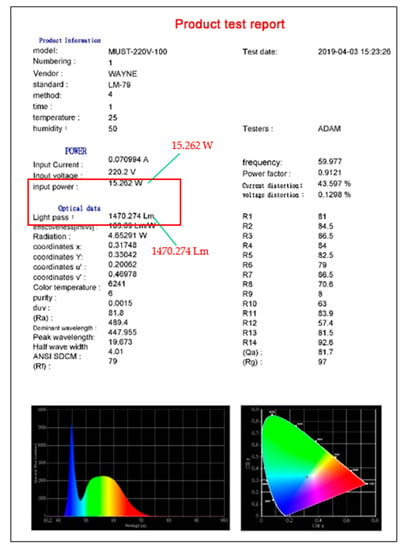
Figure 6.
Test data in high-light mode.
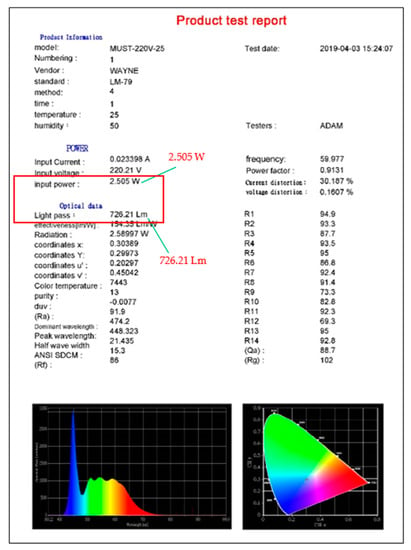
Figure 7.
Test data in low-light mode.
From the test data in Figure 6 and Figure 7, it can be seen that the luminous flux in high-light mode is 1470.274 Lm, and the luminous flux in low-light mode is 726.21 Lm, meaning that the brightness in low-light mode is about 49.39% of that in high-light mode. The input power in high-light mode is 15.262 W, and the input power in low-light mode is 2.505 W. The brightness in low-light mode is about 16.41% of that in high-light mode, which is significantly different from the 10% we designed. This is because the input power is measured together with those of the control circuit and the motion sensor, and the power of these two is about 1 W. If those are deducted, it is close to 10% ((2.505 − 1)/(15.262 − 1) = 10.55%).
In addition, we also purchased an illuminometer and power meter to conduct our own measurement experiments. The brand of the illuminometer is TASI, the model number is TA8121, and its maximum resolution is 0.1 LUX. The brand of the power meter is WANF, the model number is WF-D02A, and its maximum resolution is 0.1 W. Below are the measurement results taken with the TASI TA8121 illuminometer (5 cm away from the lamp tube) (Figure 8):

Figure 8.
Luminous flux in high-light mode and low-light mode.
The above experiment results show that the luminous flux in high-light mode is 1548 Lm, and that in the low-light mode is 708 Lm. The luminous flux in low-light mode is about 45.74% of that in high-light mode, which is not much different from the 49.39% in the results obtained by the laboratory. Below are the results we measured with our WANF WF-D02A power meter (Figure 9):
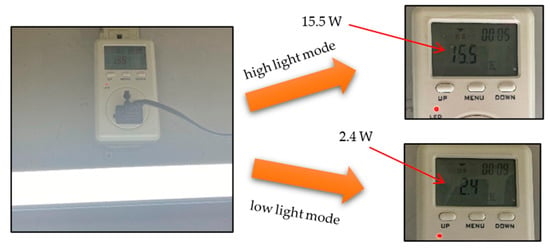
Figure 9.
Power consumption in high-light mode and low-light mode.
The power measured in the above-mentioned experiments is 15.5 W in the high-light mode and 2.4 W in the low-light mode, and the brightness of the low-light mode is about 15.48% of that of the high-light mode, which is significantly different from the 10% we designed. Similarly, it is because the input power is measured together with those of the control circuit and the motion sensor, and the power of the two is about 1 W. If those are deducted, it is about 10% ((2.4 − 1)/(15.5 − 1) = 9.66%).
5. User Satisfaction Analysis
In this study, a total of 249 people completed the questionnaire, of which 46% were males and 54% were females. User satisfaction is divided into four aspects: “overall”, “parking lots”, “corridors, stairwells” and “toilets”, and the analysis results are shown in Table 3. The average ranking of the overall satisfaction shows that the top three satisfaction ratings of the sensor lamp are “I think this sensor lamp can help maintain a certain level of brightness in the corridors and stairwells without wasting electricity” (m = 4.8), “I think the function of low-light mode (half brightness) is very good” (m = 4.77), “I think this sensor lamp is very energy efficient” (m = 4.76), and “I would recommend this sensor lamp to others” (m = 4.76).

Table 3.
Satisfaction Analysis Table.
In terms of the satisfaction for the “parking lots”, “When this sensor lamp is installed in a “parking lot”, I think the lamp stays on for just the right length of time (currently 30 s) when someone passes by” (m = 4.37)” is the most popular among consumers. In terms of satisfaction for “corridors and stairwells”, “When this sensor lamp is installed in “corridors and stairwells”, I think its sensitivity and response distance are appropriate” (m = 4.36) is the most popular among users. In terms of satisfaction for the “toilets”, “When this sensor lamp is installed in the “toilets”, I think the brightness of this lamp in low-light mode is just right” (m = 4.27) is the most popular among consumers.
According to the above results, the satisfaction rate of this sensor lamps installed in different areas is in the order of parking lot > corridors, stairwells > toilets, and “Full brightness when someone passes by and maintain for 30 s” is the most popular among consumers. To conclude, this sensor lamp can maintain brightness and provide proper response while saving energy, and it is satisfactory to the consumers.
We design 4 modes of intensity as 65%, 50%, 35%, and 20% of high-light mode to experiment the most appropriate intensity in our low-light mode. The experimental result of 20 subjects as below: 12 subjects responded positively to 50% intensity of high-light mode, 2 subjects responded positively to 65% intensity of high-light mode, 2 subjects responded positively to 35% intensity of high-light mode, and 4 subjects responded positively to 20% intensity of high-light mode. It will be seen from this result that the 50% intensity of high-light mode is the most appropriate intensity for alleviating the discomfort of brightness variation.
6. Discussion
From the above discussion, it is known that the power consumption of this new type sensor lamp in low-light mode is only one-tenth of that in high-light mode, but its brightness can be up to half of the high-light mode, which is very suitable for the sensor lighting in the parking lots, corridors, stairwells, and toilets. It only requires the replacement of the lamp but not the original lamp socket, yet the basic brightness can be maintained. Take the general 15W T8 LED lamp (sensor-less) as an example, if it is replaced by this new type of sensor lamp, and the place where it is installed is rarely passed by people, the power saving rate will be as high as 90%. Assuming that there are 12 passers-by per hour, the saving rate is still 81%.
This work has already been adopted in many schools, including Cheng-Shu University, I-Shou University, National Chiayi Economics Vocational High School, Chiayi County Jhuci Senior High School, Budai Junior High School, Guang Rong Elementary School and so on, and it is expected to be extended to various schools nationwide.
In this paper, we use Cheng Shiu University as an example of the energy-saving analysis with the assumption that there are 12 people passing by per hour. If the frequency of passer-by is higher, the ESR will become less than 81%. Conversely, the energy-saving will be higher than 81% if the frequency of people passing by is lower. In addition, when we carried out the energy-saving analysis, we only calculated the power consumed by the lamp tube but not the circuit (about 1 W). If we include the power consumption of the circuit in the calculation (the power measured in the experiment is 15.5 W in high-light mode and 2.4 W in low-light mode, and it is assumed that the installation site is seldom passed by), the ESR is still at (15.5 − 2.4)/15.5 = 84.5%.
Author Contributions
C.-T.L. focus on the writing and integrating articles for research conceptual architecture, literature review, and product analysis. P.-T.H. writes data acquisition, statistical analysis, and data analysis. Besides, he adjusts the overall writing of the article. All authors have read and agreed to the published version of the manuscript.
Funding
This research received no external funding.
Conflicts of Interest
The authors declare no conflict of interest.
References
- Sin-Rong, C. Effect of Light Emitting Diode Lumileds and Photovoltaic on Electric system in Taiwan. Master’s Thesis, National Cheng Kung University, Tainan, Taiwan, 2007. [Google Scholar]
- U.K. Government. Meeting the Energy Challenge-A White Paper on Energy, Department of Trade and Industry; U.K. Government: London, UK, 2007.
- China Daily. China Eyes 20% Renewable Energy by 2020; China Daily: Beijing, China, 2009. [Google Scholar]
- Lee, K.C.; Li, S.; Hui, S.Y. A Design Methodology for Smart LED Lighting Systems Powered By Weakly Regulated Renewable Power Grids. IEEE Trans. Smart Grid 2011, 2, 548. [Google Scholar] [CrossRef]
- Li, D.H.W.; Cheung, K.L.; Wong, S.L.; Lam, T.N.T. An analysis of energy-efficient light fittings and lighting controls. Appl. Energy 2010, 87, 558. [Google Scholar] [CrossRef]
- Tan, Y.K.; Huynh, P.T.; Wang, Z. Smart personal sensor network control for energy saving in DC grid powered LED lighting system. IEEE Trans. Smart Grid 2013, 4, 669. [Google Scholar] [CrossRef]
- US Energy Information Administration. Commercial Building Energy Consumption Survey; U.S. Energy Information Administration: Washington, DC, USA, 2003.
- Ozcelik, M.A. Light sensor control for energy saving in DC grid smart LED lighting system based on PV system. J. Optoelectron. Adv. Mater. 2016, 18, 468–474. [Google Scholar]
- Farsakoglu, O.F.; Atik, I. Analysis of the factors affecting operation and efficiency of power LED drivers and circuit design. Optoelectron. Adv. Mat. 2015, 9, 1356. [Google Scholar]
- Chiu, J.H.; Lo, Y.K.; Chen, J.T.; Cheng, S.J.; Chung, Y.L.; Mou, S.C. A high-efficiency dimmable LED driver for low-power lighting applications. IEEE Trans. Ind. Electron. 2010, 57, 735. [Google Scholar] [CrossRef]
- Manuel, A.; Lamar, D.G.; Sebastian, J.; Balacco, D.; Aguissa, D.; Manuel, A.; Lamar, D.G.; Sebastian, J.; Balacco, D.; Aguissa, D. High-Efficiency LED Driver without Eletrolityc Capacitor for Street Lighting. IEEE Trans Ind. Appl. 2013, 49, 127. [Google Scholar]
- Li, S.; Chen, H.; Tan, S.C.; Hui, S.Y.; Waffenschmidt, E. Power flow analysis and critical design issues of retrofit light-emitting diode (LED) light bulb. IEEE Trans. Power Electron. 2015, 30, 3830. [Google Scholar] [CrossRef][Green Version]
- Bureau of Energy, MOEA. New Century Power-Saving Environmental Lighting. Available online: https://energymagazine.itri.org.tw/Cont.aspx?CatID=30&ContID=542 (accessed on 20 May 2019).
- LEDinside. The Global LED Indoor Commercial Lighting Market Would Reach USD15.87 Billion in 2018, Accounting for 42% of the Global LED Lighting Production Value. Available online: https://www.ledinside.com.tw/research/20180427-35233.html (accessed on 24 March 2018).
- Huang, B.J.; Wu, M.S.; Hsu, P.C.; Chen, J.W.; Chen, K.Y. Development of high-performance solar LED lighting system. Energy Convers. Manag. 2010, 51, 1669–1675. [Google Scholar] [CrossRef]
- Hadj, A.A.; Chenlo, F.; Benghanem, M. Loss-of-load probability of photovoltaic water pumping systems. Sol. Energy 2004, 76, 713–723. [Google Scholar] [CrossRef]
- Yoonsik, U.; Hong, I.; Kim, G.; Lee, B.; Park, S. Design and implementation of power-aware LED light enabler with location-aware adaptive middleware and context-aware user pattern. IEEE Trans. Consum. Electron. 2010, 56, 231–239. [Google Scholar]
- DT-LUX LED. Latest News. Query on LED Energy-Saving Lighting Subsidy Application in Taiwan: Community and Service Industry Can Apply for a Maximum Subsidy of NT$750 per Lamp. Available online: http://www.dt-lux.com.tw/LED%20FAQ/LED%20FAQ.html (accessed on 28 May 2019).
© 2020 by the authors. Licensee MDPI, Basel, Switzerland. This article is an open access article distributed under the terms and conditions of the Creative Commons Attribution (CC BY) license (http://creativecommons.org/licenses/by/4.0/).